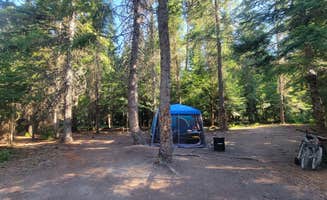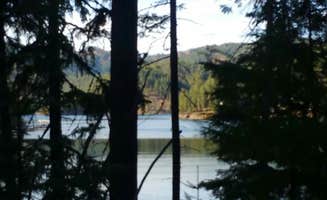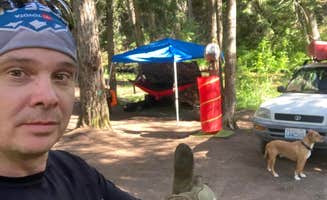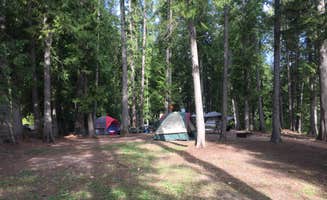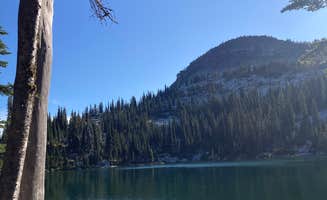Dispersed camping near Cusick, Washington offers backcountry experiences in the Colville National Forest, where elevations range from 1,200 to over 7,000 feet. Summer temperatures typically reach the 80s during day and cool to the 40s at night, creating significant temperature swings campers should prepare for. Most campsites require at least moderate clearance vehicles, with several areas becoming difficult to access after rainfall.
What to do
Swimming spots: Check water conditions. At Cooks Lake, the water remains warm enough for swimming throughout summer. One camper reported, "The water was warm and we swam all day. Bats at night, and the stars!!" The lake features a dirt and rock beach about 150 feet long.
Creek exploration: Wade carefully. Sullivan Creek provides multiple access points from nearby campsites. A visitor noted, "The river is about 35 yards from the site and the dirt road is about 20 yards from the main Camping area." Early summer brings fast water conditions, making swimming unsafe until later in season.
Fishing: Bring proper gear. Potters Pond within Little Pend Orielle Wildlife Refuge stocks rainbow trout. According to a visitor, "There is a family friendly fishing dock on Potters pond, and it is stocked with good sized rainbow trout the little kids had a blast fishing." Nearby Bayley Lake offers fly fishing opportunities but requires appropriate permits.
What campers like
Wildlife viewing: Morning wildlife activity. The area hosts diverse wildlife including woodpeckers, killdeer, chipmunks, rabbits, and various aquatic species. At Cooks Lake, a camper observed, "The mist rising and the vast, green mountains, right in front of you! Birds everywhere, woodpeckers in the birch trees and killdeer darting down to the water. Chipmunks and rabbits. Tadpoles and turtles and little water snakes."
Site separation: Privacy between campsites. Cee Cee Ah Creek offers well-separated camping areas. A reviewer commented, "Nearby campsites are far enough away that you have plenty of privacy. There is a creek that runs through this area, which is great for cooling off on hot days."
Natural features: Creek sounds and shade. Campsites positioned near water features provide natural white noise. At North Fork Chewelah Creek, a camper experienced "a beautiful camp ground. Small space with multiple dispersed camp sites along the creek and throughout the wooded area. The creek is very small but powerful." Most sites feature substantial tree cover for shade during hot summer days.
What you should know
Road conditions: Prepare for rough terrain. Access to Pack River involves "Lots of washboard/rutted sections on the road and some steep areas getting to certain campsites." Many forest service roads deteriorate after rain, requiring high-clearance vehicles.
Wildlife awareness: Bears active in area. Multiple campgrounds report bear activity. One camper at Sullivan Creek mentioned, "Did have a late night bear visitor but was camping in my van so not too concerning." Bear boxes are available at some sites but not all.
Water sources: Bring your own. While creeks and lakes provide water for recreation, potable water requires filtering or hauling in. At Little Pend Orielle Campground, "There is a pit toilet (locked due to current COVID restrictions), and a fire ring at each dispersed campsite. No water, except for the creek, and not even any cell phone reception."
Tips for camping with families
Fire pits: Check site amenities. Most dispersed sites include established fire rings. A North Fork Chewelah Creek visitor found "established stone fire pits or you can gather up some rocks and make your own. Plenty of deadfall and fire wood all over the place."
Swimming options: Kid-friendly areas. Little Pend Orielle Campground offers water access at Potters Pond. One visitor noted, "We opted for a spot right by potters pond. It was very spacious and was walking distance from the dock and a toilet facility."
Wildlife education: Teachable moments. Morning and evening hours provide optimal wildlife viewing. A visitor shared, "We saw very little wildlife (probably due to hunting season), and were probably two weeks early to see the fall colors." Planning camping trips during spring or fall migration periods increases wildlife sighting opportunities.
Tips from RVers
Site selection: Check access before committing. At PauPac Road Camp, "4 wheel drive needs for lots of these roads. This main campsite has glass and garbage, but there are campsites all through here." Always scout sites before attempting to back in larger vehicles.
Leveling challenges: Bring blocks. Few dispersed sites offer naturally level parking. One Cooks Lake visitor mentioned, "At least 2 of them are good for me trailer although I wouldn't try if you're not experienced with towing. The road to get there was approx six miles of gravel winding single lane road."
Loop access: Limited turnaround space. Many forest roads lack proper turnaround areas for larger rigs. Little Pend Orielle campsites have "narrow gravel roads, so 'large' rigs and/or trailers may find it a challenge." Some campers recommend unhitching before navigating to campsites when towing.



